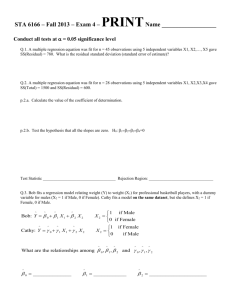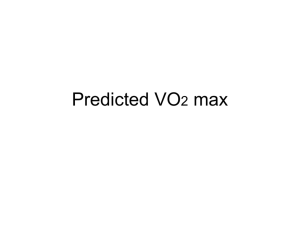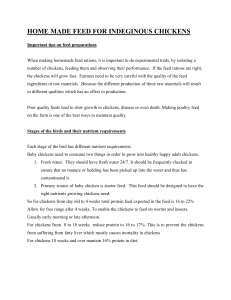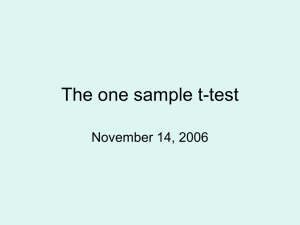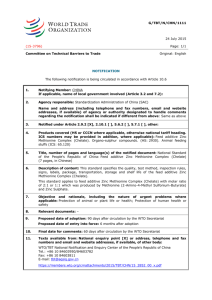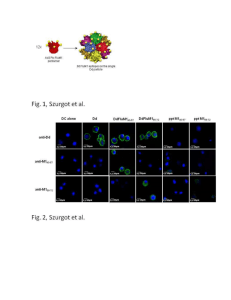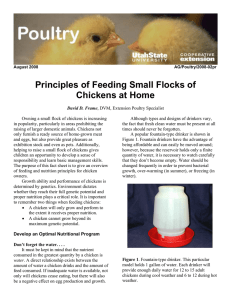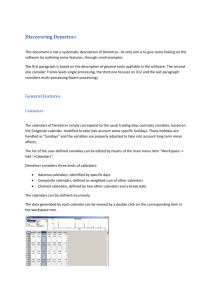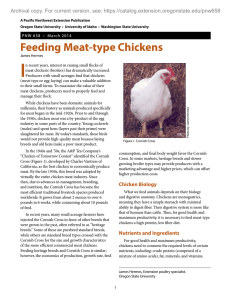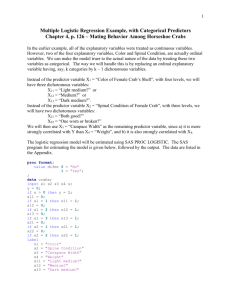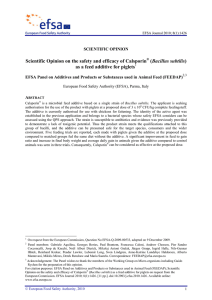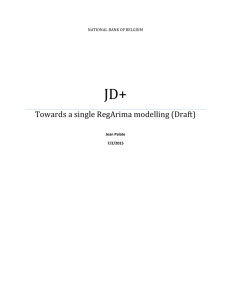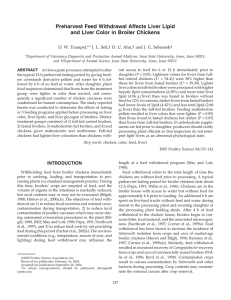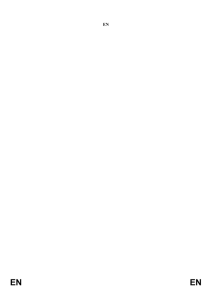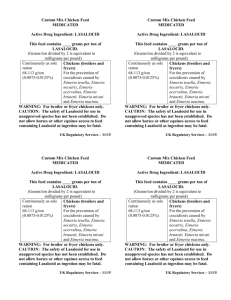ST512_HW3
advertisement
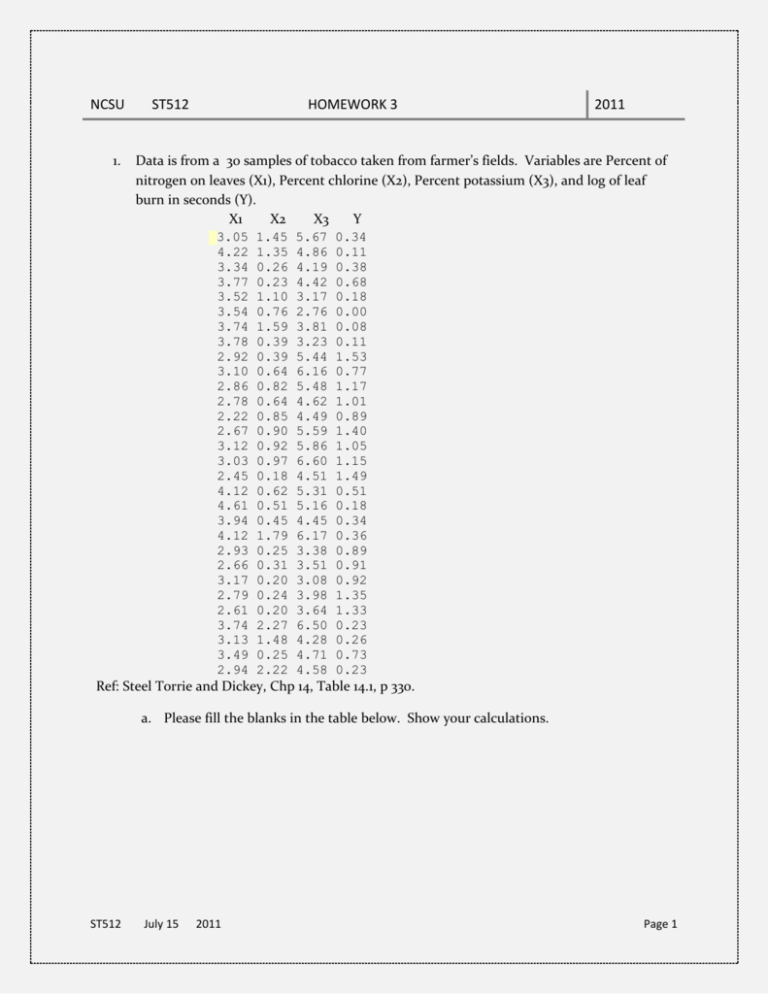
NCSU ST512 HOMEWORK 3 2011 1. Data is from a 30 samples of tobacco taken from farmer’s fields. Variables are Percent of nitrogen on leaves (X1), Percent chlorine (X2), Percent potassium (X3), and log of leaf burn in seconds (Y). X1 X2 X3 Y 3.05 1.45 5.67 0.34 4.22 1.35 4.86 0.11 3.34 0.26 4.19 0.38 3.77 0.23 4.42 0.68 3.52 1.10 3.17 0.18 3.54 0.76 2.76 0.00 3.74 1.59 3.81 0.08 3.78 0.39 3.23 0.11 2.92 0.39 5.44 1.53 3.10 0.64 6.16 0.77 2.86 0.82 5.48 1.17 2.78 0.64 4.62 1.01 2.22 0.85 4.49 0.89 2.67 0.90 5.59 1.40 3.12 0.92 5.86 1.05 3.03 0.97 6.60 1.15 2.45 0.18 4.51 1.49 4.12 0.62 5.31 0.51 4.61 0.51 5.16 0.18 3.94 0.45 4.45 0.34 4.12 1.79 6.17 0.36 2.93 0.25 3.38 0.89 2.66 0.31 3.51 0.91 3.17 0.20 3.08 0.92 2.79 0.24 3.98 1.35 2.61 0.20 3.64 1.33 3.74 2.27 6.50 0.23 3.13 1.48 4.28 0.26 3.49 0.25 4.71 0.73 2.94 2.22 4.58 0.23 Ref: Steel Torrie and Dickey, Chp 14, Table 14.1, p 330. a. Please fill the blanks in the table below. Show your calculations. ST512 July 15 2011 Page 1 Parameter Estimates Variable Parameter Standard DF Estimate Error t Value Pr > |t| Type I SS Type II SS Intercept 1 2.56226 0.39767 6.44 <.0001 x1 1 -0.75685 0.11137 -6.80 <.0001 x2 1 -1.45070 0.41538 -3.49 0.0018 x4 1 0.29941 0.12141 2.47 0.0209 x3 1 0.20686 0.03718 5.56 <.0001 14.11788 1.58242 b. Show Type I SS o ny 2 c. Write the multiple regression equation. d. Test the hypothesis H o : 3 0 vs H o : 3 0 Use =0.05 e. Test the hypothesis H o : 4 0 vs H o : 4 0 Use =0.05 f. Test the hypothesis H o : 2 3 0 vs H o : not all i 0 Use =0.05 g. A friend asked you to compute the regression equation that show the effect of X1 and X2 on Y when X3 is kept constant at its average value. You need to show her that the coefficient of X2 depends on X1. Find out the regression coefficient for X2 when X1 = 3, and also for X1= 4. h. Should we expect the slope for X2 become positive? If yes, at what value of X1? 1 model y= x1 x2 x3 pred 2.84 1.51 4.61 0.18 3.81 x1 -1.16 2.27 3.02 1.57 x2 0.88 0.18 2.22 2) A poultry Scientist was studying a the creation of a new diet. A food additive added to the standard basal diet. He have varying amount of the additive: 0 20 40 60 80 100, and each of the 6 diets were assigned to 10 chickens. 5 chickens in each group received additionally 400 ppm of copper while the remaining 5 chickens received no copper. At the end of the study the ST512 July 15 2011 Page 2 feed efficiency ratio (feed consumed(gm) to weight gain (gm) was obtained for the sixty chickens. Data is attached. a. Fit the following two regression equations Model 1: y o 1 x1 2 x12 3 x13 e Model 2 : y o 1 x1 2 x12 3 x2 e Model 3 : y o 1 x1 2 x12 3 x2 4 x1 x2 5 x12 x2 e Y= Feed Efficiency ratio, X1 = Amount of feed additive, X2 = Amount of copper placed in feed. b. Which models appears to provide the better fitting to the data. Justify your answer. c. Display the predicted equation for the best fitting model. Ref” Ott and Longnecker, Ex. 14.14 , p 735 Data Cu Additive FeedEffRatio 0 0 0 0 0 400 400 400 400 400 0 0 0 0 0 400 400 400 400 400 0 0 0 0 0 400 400 400 400 400 ST512 0 0 0 0 0 0 0 0 0 0 20 20 20 20 20 20 20 20 20 20 40 40 40 40 40 40 40 40 40 40 July 15 1.3 1.35 1.44 1.52 1.56 1.61 1.48 1.56 1.45 1.14 2.17 2.11 2.08 2.13 2.22 2.29 2.33 2.24 2.16 2.21 2.3 2.34 2.2 2.38 2.48 2.44 2.37 2.43 2.37 2.41 2011 Page 3 0 0 0 0 0 400 400 400 400 400 0 0 0 0 0 400 400 400 400 400 0 0 0 0 0 400 400 400 400 400 ST512 60 60 60 60 60 60 60 60 60 60 80 80 80 80 80 80 80 80 80 80 100 100 100 100 100 100 100 100 100 100 July 15 2.47 2.51 2.79 2.4 2.55 2.67 2.5 2.55 2.6 2.49 3.31 3.17 3.24 3.21 3.35 3.38 3.42 3.36 3.25 3.51 4.92 3.87 4.81 4.88 5.06 5.09 4.97 4.95 4.59 4.76 2011 Page 4

